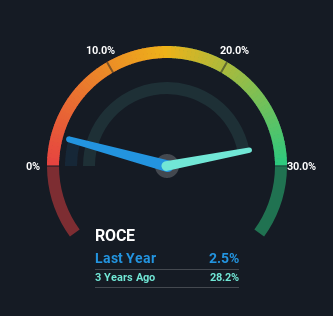
What trends should we look for it we want to identify stocks that can multiply in value over the long term? Amongst other things, we'll want to see two things; firstly, a growing return on capital employed (ROCE) and secondly, an expansion in the company's amount of capital employed. Basically this means that a company has profitable initiatives that it can continue to reinvest in, which is a trait of a compounding machine. Having said that, from a first glance at Shrenik (NSE:SHRENIK) we aren't jumping out of our chairs at how returns are trending, but let's have a deeper look.
What is Return On Capital Employed (ROCE)?
For those who don't know, ROCE is a measure of a company's yearly pre-tax profit (its return), relative to the capital employed in the business. Analysts use this formula to calculate it for Shrenik:
Return on Capital Employed = Earnings Before Interest and Tax (EBIT) ÷ (Total Assets - Current Liabilities)
0.025 = ₹28m ÷ (₹3.6b - ₹2.5b) (Based on the trailing twelve months to March 2022).
Thus, Shrenik has an ROCE of 2.5%. In absolute terms, that's a low return and it also under-performs the Trade Distributors industry average of 7.1%.
View our latest analysis for Shrenik

Historical performance is a great place to start when researching a stock so above you can see the gauge for Shrenik's ROCE against it's prior returns. If you want to delve into the historical earnings, revenue and cash flow of Shrenik, check out these free graphs here.
What Does the ROCE Trend For Shrenik Tell Us?
On the surface, the trend of ROCE at Shrenik doesn't inspire confidence. To be more specific, ROCE has fallen from 24% over the last five years. Given the business is employing more capital while revenue has slipped, this is a bit concerning. This could mean that the business is losing its competitive advantage or market share, because while more money is being put into ventures, it's actually producing a lower return - "less bang for their buck" per se.
On a side note, Shrenik's current liabilities are still rather high at 69% of total assets. This can bring about some risks because the company is basically operating with a rather large reliance on its suppliers or other sorts of short-term creditors. Ideally we'd like to see this reduce as that would mean fewer obligations bearing risks.
What We Can Learn From Shrenik's ROCE
We're a bit apprehensive about Shrenik because despite more capital being deployed in the business, returns on that capital and sales have both fallen. This could explain why the stock has sunk a total of 83% in the last three years. Unless there is a shift to a more positive trajectory in these metrics, we would look elsewhere.
Shrenik does have some risks, we noticed 4 warning signs (and 2 which shouldn't be ignored) we think you should know about.
While Shrenik may not currently earn the highest returns, we've compiled a list of companies that currently earn more than 25% return on equity. Check out this free list here.
New: Manage All Your Stock Portfolios in One Place
We've created the ultimate portfolio companion for stock investors, and it's free.
• Connect an unlimited number of Portfolios and see your total in one currency
• Be alerted to new Warning Signs or Risks via email or mobile
• Track the Fair Value of your stocks
Have feedback on this article? Concerned about the content? Get in touch with us directly. Alternatively, email editorial-team (at) simplywallst.com.
This article by Simply Wall St is general in nature. We provide commentary based on historical data and analyst forecasts only using an unbiased methodology and our articles are not intended to be financial advice. It does not constitute a recommendation to buy or sell any stock, and does not take account of your objectives, or your financial situation. We aim to bring you long-term focused analysis driven by fundamental data. Note that our analysis may not factor in the latest price-sensitive company announcements or qualitative material. Simply Wall St has no position in any stocks mentioned.
About NSEI:SHRENIK
Shrenik
Engages in processing and trading of paper, pulp, and paperboard products in India.
Slight and fair value.
Market Insights
Community Narratives




